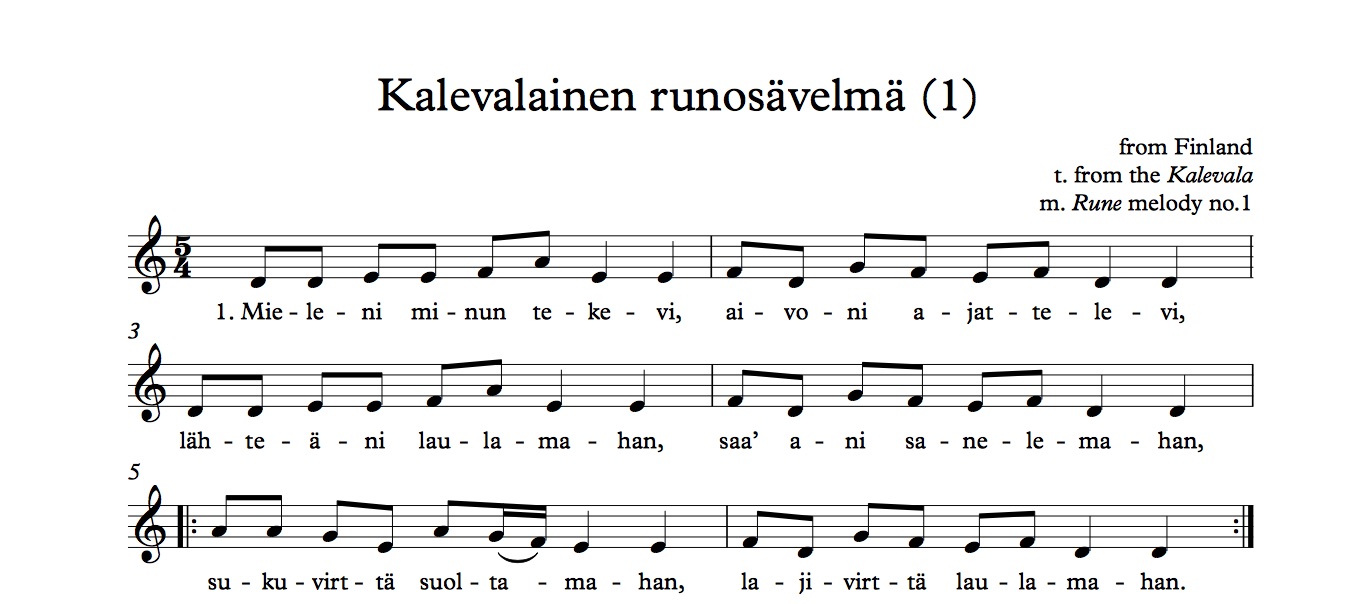Celebrating Finnish folk songs: Finland’s centennial anniversary
“The history of mankind has been the history of worry and grief. But there have also been joys, and through the ages foremost among them the joy of music and singing…” Rahikainen & Uusitalo, 1984
This year is Finland’s big year because it marks Finland’s 100 years of independence. As Finns all over the world come together to celebrate, old Finnish folk tunes will be heard and remembered once more. There are two types of Finnish folk songs: rhymed folk songs and Kalevala-songs. The two types are distinguished by their use of rhyme and alliterations as well as metre. In addition to telling the mythological stories and the creation story which is written in the Kalevala, Finnish folk songs also speak of long winter nights, sorrows, and of love stories. As one dives into Finnish music, it is easy to see the beauty of the Finnish culture as well as their music.
Songs from the Kalevala
Historically, Finnish folk music dates back to the old tradition of singing ancient poetry from the Kalevala. The Kalevala is a Finnish epic which contains oral folklore and mythology. Complied by Elias Lönnrot in 1835, the Kalevala is often considered to be one of the most significant works in Finnish literature. Because the Kalevala created a new type of poetry based on alliteration and on parallelism, a new art form in music was formed. One of the central characters of the Kalevala, Väinämöinen, a master musician and the first kantele player, used his music to cast spells and chants. Because of this, traditionally many of the Kalevala poems were sung and accompanied by the kantele, an ancient plucked zither. Although the kantele is thought to be between 1,000 and 3,000 years old, it has a strange resemblance to other older dulcimers around the world such as the quanun from the Middle East, the Chinese guzheng, and the Japanese koto. Despite its resemblance, the tone of the kantele is quite unique; it sounds calming like a harp, yet it has an ancient and almost mystic feel to it. The tone is pure and exact unlike the other dulcimers noted which bend pitches to create quarter tones and to create an exotic sound. In the Kalevala, the beauty of the kantele lures all the forest creatures. Often poetry was sung in metres such as 5/4 or 7/4 .The beautiful Kalevalainen Runosävelmä, or “an old song of Kalevala” is an example of the enchanting kantele and the 5/4 metre.This folk song has been adapted both instrumentally and vocally.
Although melancholy and simple, it is quite beautiful. It has a very natural and pure sound, which is common in Finnish folk songs. It transports its listeners to an ancient, medieval and cold world.The lyrics are the opening words of the Kalevala, which Väinämöinen sings while playing the kantele.

Like Kalevalainen runosävelmä, Tuoll’ on mun kultani is another fairly well-known love song originating from the Kalevala. This songs tells of a man ‘s yearning for his beloved. Unlike the other Kalevala songs, this song is in 2/4 metre and follows a different rhyming scheme. Interestingly for English speakers, the word “kultani” which means sweetheart, or beloved, has the root “kulta”, can mean gold or someone who is very dear. Despite being a love song, the mode is minor to represent the yearning and unsettlement.
Themes of sorrow and yearning
As one listens to Finnish folk music, one is often struck by a sense of extreme melancholy. Most of the folk music is written in a minor mode which allows the music to express the beauty and reality of sadness, yearning and nostalgia. In addition, some of these songs do not follow the typical Western harmonies and are more modal, giving them a raw, native, and ancient sound. Many of these Finnish folk songs developed during the bleak time of Finland’s war with Russia, which would explain the darker sentiments expressed in these folk tunes.For example, a famous Finnish folk song Karjalan Kunnailla, or Karelian Spring, is a patriotic song that speaks of yearning for the Karelia’s spring beauty.
Although very melancholic, the lyrics speak of beauty and hope:
“The hills of Karelia grow veiled with green,
The birches new crowns do so shimmer and sheen,
The cuckoo calls spring, the glades ring with song,
How boundless my yearning for where I belong”
Translated into English by Martha Kuusisto
Despite the nationalist sentiments expressed in this song, it is evident that there are sentiments of nostalgia and yearning. Many of these songs developed Finland’s national identity and although Finland’s culture and music and been influenced by Russia, Germany and Sweden, many folk songs, like this one, speak of the truly of the Finnish identity.
The Forest: A national symbol
In addition to exploring feelings of sorrow, yearning and loneliness, Finnish folk music explores national symbols that are unique to the region. The forest is a very important the Finns. Finland is about 65% forest, making the forest a part of Finnish culture. Different trees are often mentioned in Finnish folk songs such as the birch tree. In addtition, Many Finnish folk songs explore feelings around the forest. Although in other cultures and literatures the forest is seen as dark, unsafe and full of perils, the forest is a symbol of peace for the Finns. One of the most beautiful folk songs speaking about the forest, is the rhyming Läksin mina kesäyonä käymään (One night in summer). Again, like Karjalan Kunnailla, the musical mode is minor making the song sound darker, yet it has a very raw sound to it.
It sounds almost like an ancient hymn and the rhyming nature of the lyrics allows the song to be easily remembered. This song tells of a narrator seeking peace in the forest when he/she comes across a maiden weeping for her lover who traveled by ship but has not yet returned. The last verse tells of the maiden seeing her lover’s ship and the maiden expressing her thanks.
“Walking all alone one night in summer,
In a valley I heard the morning awaken,
Where the birds were singing, setting
All the echoes ringing; and my heart was
Seeking peace and quiet in the forest”
Translated into English by Alex Bryan
Seeking peace in the forest is a common theme in several folk songs. Tuonne taakse metsämaan ( yearning), expresses the yearning for the forest’s peace and hope.
“Full of yearning is my heart for the woodlands yonder
and the peace which they import makes my longing stronger
Hidden there among the trees my darling sweetheart’s waiting”
Translated into English by Alex Bryan
Like the other folk songs discussed, this one is also in the minor mode, but has a very distinct sound to it. It has a lilt which gives it more movement then the other folk songs. Through these folk songs, it is evident that nature is very important to their culture.
Blue and White: National colours
“The folk songs of Finland, like the folk songs indeed of all countries, reveal much of the character of her people and their approach to nature and to each other” Robert Armstrong
Like the forest, the colours blue and white place a special significance for the Finns. It is the colours of the Finnish flag, the water, the snow, the clouds and the sky. Taivas on sinner ja valkoninen ( Blue and white is the summer sky) is a highly expressive song which poetically describes the importance of the colours blue and white. It is analogy of how the blue and white sky is full of stars at night just like a heart which is filled with thoughts of sadness. The narrator of the song expresses his feelings to only the blue and white sky. Although sorrowful, this song conveys a very real sentiment when sometimes the best console and listener is nature.
Tying the old with the new to create a national identity: Sibelius
One of the most iconic Finnish songs is Sibelius’ Finlandia hymn. Sibleus is famous for creating Finland’s national identity through music. Highly influenced by the Kalevala and Finnish folk music, he was an integral part of establishing Finnish identity through music. Although not quite considered as old as the other folk tunes discussed, Finlandia hymn is almost just as important as the Finnish national anthem. It tells the story of Finnish victory and pride. Although not in the minor mode, it is patriotic and bold yet has its unique Finnish melancholy sound which the other folk songs presented. Sibelius is remembered for developing Finland’s nationalistic aura through music.As Finland turns one hundred this year, this famous anthem is a wonderful one to listen to and explore.
“Finland, behold, thy daylight now is dawning,
the threat of night has now been driven away.
The skylark calls across the light of morning,
the blue of heaven lets it have its way,
and now the day the powers of night is scorning:
thy daylight dawns, O Finland of ours!”
Finnish folk music has left a legacy: it has taught others of the true Finnish culture and identity, it has influenced current Finnish music, and it has shown how much literature and song are connected. Dating back to the Kalevala, folk music became an important part of the Finnish identity especially during the Soviet invasion of Finland. Becuase Finland had a dark history, their folk songs often speak of sorrow, loneliness, and yearning. Yet through suffering and sorrow some of the most beautiful works of music emerged. Finnish folk music had a many revivals:first with the great Finnish composer Sibelius who transformed folk tunes into large musical works and then again during the 1960’s and 70’s when there was rapid industrialization. Until today, the traditional folk music continues to play an important part in the Finnish identity. Not surprisingly, since many of the folk songs have a darker undertone, gothic metal, which is a dark and introspective musical genre, flourishes in Finland today. Finnish folk music will live from generation to generation and will continue to be remembered throughout the years to come.
Works Cited
Armstrong, R. (1975). Finnish Odyssey: poetry and folk songs of Finland in translation. London, Great Britian: Research Publishing Co.
Rahikainen, E., & Uusitalo, H. (1984). Soumalaisa Kansanlauluja- Finnish Folk songs. Helsinki, Finland: Musiikki Frazer.
This article is dedicated to R.V., a Finnish woman suffering from Alzheimer’s, who through our music therapy sessions relived her memories by many of these Finnish folk songs—
What do you think? Leave a comment.











The music is so spiritually uplifting. Love it.
I wish I knew other people who love Finnish folk music as much as I do. I’m pretty sure there are a couple of people in my life who would be willing to listen to culturally-related music but have yet to hear this type of world music.
I do! It’s really fun to listen to music of different cultures!
I’ve recently starting hearing this type of music not only because my best friend is finnish, but because the culture/language is so beautiful.
I have to admit that this is a new subject to me so thanks for opening my eyes. An excellent article to boot.
Hauntingly beautiful music. Thanks for sharing!
Hauntingly beautiful. Music is truly an international language. Thank you for sharing.
I’m really not keen on this music at all. I’m not saying other people aren’t gonna love it, but, it doesn’t sound that good to me, I’m sorry. No hard feelings.
To each their own, but I take it if you aren’t into this, you aren’t likely into any other folk music styles, as this music has overtones of Gaelic Celtic Swiss “French waltz” and Ukrainian music and Norse Norwegian musical groups. If folk music isn’t your thing, you probably throw all the folk traditional in one bucket in the mind.
I’m a london lad born and bred, but have been going to Finland (Suomi) for nearly 20 years my children (all 3) are proper Finns and go back to the mother land once every year. I love the place, the people, the culture. Finland is a great country,
Finns, please, don’t give up your language, culture and traditions, stay there forever and hold this, because you’ve got something that can’t be lost, never.
Beautiful! My dad is Finn and my mom was Irish and Hungarian. I love their music and culture! Thank you for the article covering it!
I love Suomi!
I deeply love with finnland from i was a child and alway feels familiar with the cultures , aih… wish one day i can visit this gorgeous land in reality.
This music is amazingly touched my soul!
People don’t believe me when I tell them there is magic in those eastern Europe and near-Karelian parts. Then I introduce them to Finish folk music…
Finnish music inspires me so much.
OMG! I love this music! Thank you so much for introducing it to us!
I’m Finnish and I didn’t even knew Finland has it own tradional music genre
For some reason i’d rather listen to this than most modern finnish pop songs… and that’s not a “i was born in the wrong generation” thing. in fact i think i couldn’t have been born at a better time.
Like Middle-Earth music.
I love you, Finland. I’m dreaming to visit it some day. Very brave nation, you have my respect.
As an Estonian, finish folk music is beautiful.
The music is very beautiful… I hope to visit Finland when I’m older.
The people of FInland have always welcomed me in a very cordial, congenial manner. Their country and their music is beautiful. I have been there six times and I look forward to returning there.
This is so timely! We are doing a Finnish centennial celebration here in Seattle and are doing research for art songs, etc. Thank you for posting this!
Glad to hear this was helpful!
This topic was expressed with clarity and intrigue. It reminded me of another Scandinavian art form, the folktale. Plain and simply adept at stimulating the imagination, either through songs, tales, or any craft.
A 1841 Norwegian folktale by Jørgen Moe and Peter Christen Asbjørnsen.
(Note: shoon is a shoe, bairns are children)
‘Then they built themselves houses,
And stitched themselves shoon,
And had so many bairns
They reached up to the moon.’
I listen to a lot of Finnish music and I can speak the language as well. I have a lot of Finnish friends and I go to Finland at least once a year.
I had the great privilege of hearing a Finnish folk band at Lotus Festival here in the states a couple years back. Armed with Accordion, voice, and violin the duo made hauntingly beautiful and organic music. I can’t remember their name at the moment but I certainly won’t forget the music they played. As a researcher of Scandinavian ballad and Danish folk music I think it would have been interesting to have heard more of the form of the Kalevala songs would have been fascinating (if there is any).
I visited Finland earlier this year and it was unexpectedly delightful. I was also lucky enough to play some Sibelius as part of a small ensemble (Violin). When I visited and saw the amazing Finnish natural scenery I could see where the inspiration for the music came from!!
The things that I can learn on a Friday afternoon. Wonderful article about a subject that I had zero background in or context for.
where did you get the sheet music screen shot from? Is it creative commons use? I would like to use the image but I would like to make sure I do so legally and respectfully.